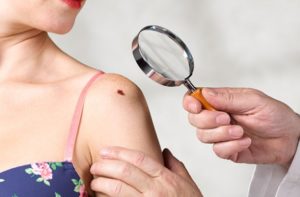Playing it Safe with Skin Moles

 Most adults have about 10 to 40 moles on their body, and they’re usually harmless. However, atypical moles can be a sign of skin cancer. That’s important because early detection can save lives.
Most adults have about 10 to 40 moles on their body, and they’re usually harmless. However, atypical moles can be a sign of skin cancer. That’s important because early detection can save lives.
Even though self-examination is simple, you may be confused about what to look for.
In general, new moles and changes in moles are a good reason to call your doctor for a checkup. Almost half of all melanomas, the most serious form of skin cancer, are discovered by patients, so be smart and master these basics.
ABCDE Rule of Skin Assessment:
The ABCDE Rule is a commonly used guide to checking moles. This helpful acronym doesn’t cover every kind of skin cancer, but it’s an excellent starting point.
1. Look for asymmetry. Normal moles look the same on both sides. Have it checked if one half of the mole doesn’t match the other.
2. Check borders. It could spell trouble if the edges of a mole start to shift. Are they ragged or uneven instead of smooth?
3. Observe colors. Darkening or multi-colors are another warning sign. That could include shades of brown and black, as well as specks of white, red, and blue.
4. Measure diameter. The overall dimensions matter. Make sure your moles are less than a quarter inch across. That’s about the size of a pencil eraser.
5. Focus on evolution. Moles that first appear after the age of 25 or undergo any visible change are of particular concern. In addition to the 4 characteristics named here, pay attention to any bleeding, oozing, itching, or tenderness.
Other Suggestions for Monitoring Skin Moles
1. Look in a mirror. Perform self-examinations with a full-length mirror and a hand-held version. They’ll help you see yourself from different angles.
2. Ask for help. A loved one can assist you with difficult spots like the top of your scalp. Take turns giving each other a hand.
3. Scan thoroughly. Start from the top of your head and work your way down to your feet. Remember less obvious places like the back of your knees and palms of your hands. Areas that are exposed to sun more often, like your face and chest, may need to be checked more often.
4. Take pictures. Photographs give you a baseline for comparison. Store them by date so you can track any changes.
5. Think beyond numbers. Experts believe that having more than 100 moles puts you at five times the normal risk for skin cancer. An easy way to estimate this is to see if you have more than 10 moles on one arm. At the same time, keep in mind that patients with very few moles can also develop melanoma, so self-examinations and checkups are still needed.
6. Start early. While skin cancer rates increase with age, children can be affected too. Check your children’s skin until they’re old enough to do it for themselves. Adopting the habit early in life will help you to become familiar with your body and more likely to spot changes.
7. Rethink tanning. Experts agree that no amount of indoor tanning is safe. When you’re outdoors, use a sunblock, especially if you have fair skin.
8. Follow your doctor’s recommendations. Doctors recommend that even low-risk individuals perform self-examinations monthly or bimonthly, and have an annual screening. Your primary care doctor or dermatologist may recommend a more frequent schedule based on your family history and other factors.
Only about 25% of adults check their skin regularly, and melanoma rates have increased dramatically over the last 30 years. Monthly self-exams and annual checkups are an easy way to protect your skin and your health.
CLICK HERE to Explore/ Our Free Online Courses
Responses